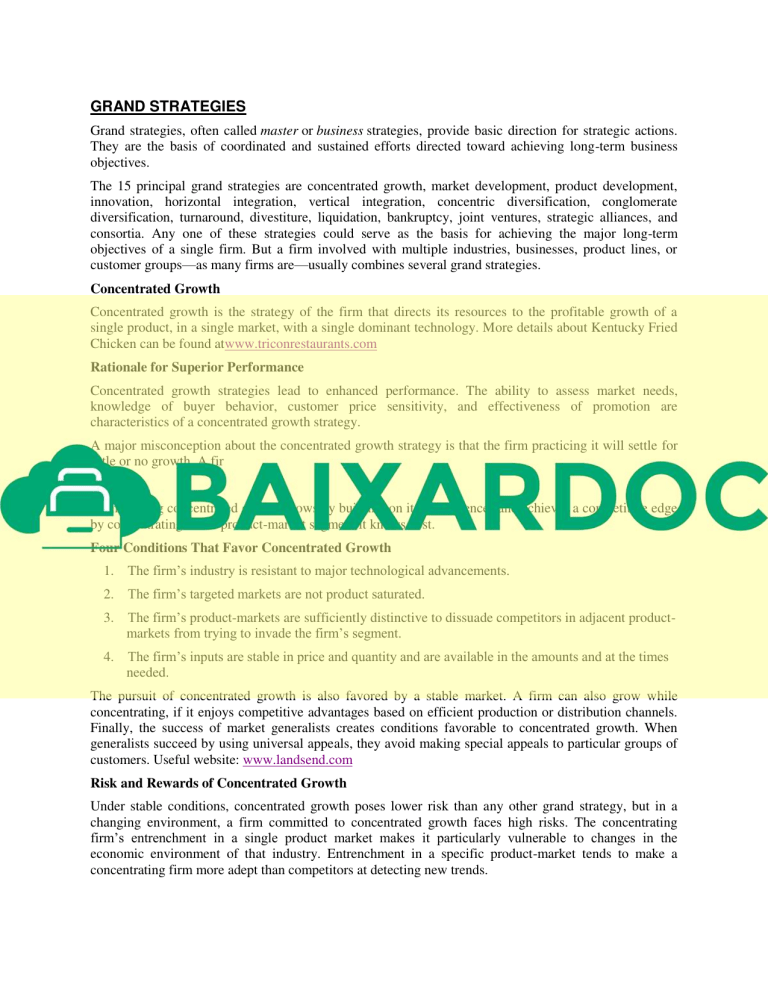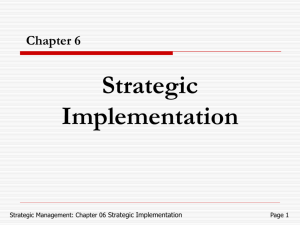
GRAND STRATEGIES Grand strategies, often called master or business strategies, provide basic direction for strategic actions. They are the basis of coordinated and sustained efforts directed toward achieving long-term business objectives. The 15 principal grand strategies are concentrated growth, market development, product development, innovation, horizontal integration, vertical integration, concentric diversification, conglomerate diversification, turnaround, divestiture, liquidation, bankruptcy, joint ventures, strategic alliances, and consortia. Any one of these strategies could serve as the basis for achieving the major long-term objectives of a single firm. But a firm involved with multiple industries, businesses, product lines, or customer groups—as many firms are—usually combines several grand strategies. Concentrated Growth Concentrated growth is the strategy of the firm that directs its resources to the profitable growth of a single product, in a single market, with a single dominant technology. More details about Kentucky Fried Chicken can be found atwww.triconrestaurants.com Rationale for Superior Performance Concentrated growth strategies lead to enhanced performance. The ability to assess market needs, knowledge of buyer behavior, customer price sensitivity, and effectiveness of promotion are characteristics of a concentrated growth strategy. A major misconception about the concentrated growth strategy is that the firm practicing it will settle for little or no growth. A fir m employing concentrated growth grows by building on its competences and achieves a competitive edge by concentrating in the product-market segment it knows best. Four Conditions That Favor Concentrated Growth 1. The firm’s industry is resistant to major technological advancements. 2. The firm’s targeted markets are not product saturated. 3. The firm’s product-markets are sufficiently distinctive to dissuade competitors in adjacent productmarkets from trying to invade the firm’s segment. 4. The firm’s inputs are stable in price and quantity and are available in the amounts and at the times needed. The pursuit of concentrated growth is also favored by a stable market. A firm can also grow while concentrating, if it enjoys competitive advantages based on efficient production or distribution channels. Finally, the success of market generalists creates conditions favorable to concentrated growth. When generalists succeed by using universal appeals, they avoid making special appeals to particular groups of customers. Useful website: www.landsend.com Risk and Rewards of Concentrated Growth Under stable conditions, concentrated growth poses lower risk than any other grand strategy, but in a changing environment, a firm committed to concentrated growth faces high risks. The concentrating firm’s entrenchment in a single product market makes it particularly vulnerable to changes in the economic environment of that industry. Entrenchment in a specific product-market tends to make a concentrating firm more adept than competitors at detecting new trends. A firm pursuing a concentrated growth strategy is also vulnerable to the high opportunity costs that result from remaining in a specific product-market and ignoring other options that could employ the firm’s resources more profitably. Over commitment to a specific technology and product-market can also hinder a firm’s ability to enter a new or growing product-market that offers more attractive cost-benefit tradeoffs. Concentrated Growth is Often the Most Viable Option The firm that chooses a concentrated growth strategy directs its resources to the profitable growth of a narrowly defined product and market, focusing on a dominant technology. The success of a concentration strategy is founded on the firm’s use of superior insights into its technology, product, and customer to obtain a sustainable competitive advantage. John Deere and Company’s home page is: www.deere.com . Exhibit 6-5 lists various options under concentrated growth. Market Development Market development consists of marketing present products, often with only cosmetic modifications, to customers in related market areas by adding channels of distribution or by changing the content of advertising or promotion. It also allows firms to practice a form of concentrated growth by identifying new uses for existing products and new demographically, psychographically, or geographically defined markets. Product Development Product development involves the substantial modification of existing products or the creation of new but related products that can be marketed to current customers through established channels. The product development strategy is based on the penetration of existing markets by incorporating product modifications into existing items or by developing new products with a clear connection to the existing product line. Innovation The underlying rationale of the grand strategy of innovation is to create a new product life cycle and thereby make similar existing products obsolete. Few innovative ideas prove profitable because the research, development, and premarketing costs of converting a promising idea into a profitable product are extremely high. Exhibit 6-6 presents the risks of new product ideas. Horizontal Integration When a firm’s long-term strategy is based on growth through the acquisition of one or more similar firms operating at the same stage of the production-marketing chain, its grand strategy is called horizontal integration. Exhibit 6-7 describes Deutsche Telekom growth strategy of horizontal acquisition. Vertical Integration When a firm’s grand strategy is to acquire firms that supply it with inputs (such as raw materials) or are a customer for its outputs (such as warehouses for finished products), vertical integration is involved. Backward integration is the desire to increase the dependability of the supply or quality of the raw materials used as production inputs. Forward integration is a preferred grand strategy if great advantages accrue to stable production. Some increased risks are associated with both horizontal and vertical integration. For horizontally integrated firms, the risks stem from increased commitment to one type of business. For vertically integrated firms, the risks result from the firm’s expansion into areas requiring strategic managers to broaden the base of their competence and to assume additional responsibilities. Exhibit 6-8 depicts both horizontal and vertical integration strategies. Concentric Diversification Grand strategies involving diversification represent distinctive departures from a firm’s existing base of operations, typically the acquisition or internal generation (spin-off) of a separate business with synergistic possibilities counterbalancing the strengths and weaknesses of the two businesses. Regardless of the approach taken, the motivations of the acquiring firms are the same: Increase the firm’s stock value. In the past, mergers have often led to increases in the stock price or the price-earnings ratio. Increase the growth rate of the firm. Make an investment that represents better use of funds than plowing them into internal growth. Improve the stability of earnings and sales by acquiring firms whose earnings and sales complement the firm’s peaks and valleys. Balance or fill out the product line. Diversify the product line when the life cycle of current products has peaked. Acquire a needed resource quickly (e.g., high-quality technology or highly innovative management). Achieve tax savings by purchasing a firm whose tax losses will offset current or future earnings. Increase efficiency and profitability, especially if there is synergy between the acquiring firm and the acquired firm. Concentric diversification involves the acquisition of businesses that are related to the acquiring firm in terms of technology, markets, or products. The ideal concentric diversification occurs when the combined company profits increase strengths and opportunities and decrease weaknesses and exposure to risk. Conglomerate Diversification In conglomerate diversification, the principal concern of the acquiring firm is the profit pattern of the venture. Unlike concentric diversification, conglomerate diversification gives little concern to creating product-market synergy with existing businesses. The principal deference between the two types of diversification is that concentric diversification emphasizes some commonality in markets, products, or technology, whereas conglomerate diversification is based principally on profit considerations. Unfortunately, the majority of such acquisitions fail to produce the desired results for the companies involved. Exhibit 6–9 provides seven guidelines that can improve a company’s chances of a successful acquisition. Textron’s home page is:www.textron.com Turnaround A firm can find itself with declining profits for many reasons such as economic recessions, production inefficiencies, and innovative breakthroughs by competitors. In many cases, strategic managers believe that such a firm can survive and eventually recover if a concerted effort is made over a period of a few years to fortify its distinctive competencies. This grand strategy is known as turnaround. It is typically begun through one of two forms of retrenchment—cost reduction or asset reduction—employed singly or in combination. Strategic management research provides evidence that firms that have used a turnaround strategy have successfully confronted decline. The research findings have been assimilated and used as the building blocks for a Model of the Turnaround Process shown in Exhibit 6–10. A turnaround situation represents absolute and relative-to-industry declining performance of a sufficient magnitude to warrant explicit turnaround actions. Turnaround situations may be the result of years of gradual slowdown or months of sharp decline. The immediacy of the resulting threat to company survival posed by the turnaround situation is known as situation severity. Severity is the governing factor in estimating the speed with which the retrenchment response will be formulated and activated. Turnaround responses among successful firms typically include two stages of strategic activities: retrenchment and the recovery response. Retrenchment consists of cost cutting and asset reducing activities. The primary objective of the retrenchment phase is to stabilize the firm’s financial condition. The primary causes of the turnaround situation have been associated with the second phase of the turnaround process, the recovery response. Recovery is achieved when economic measures indicate that the firm has regained its pre-downturn levels of performance. Divestiture A divestiture strategy involves the sale of a firm or a major component of a firm. When retrenchment fails to accomplish the desired turnaround or when a non-integrated business activity achieves an unusually high market value, strategic managers often decide to sell the firm. The reasons for divestiture vary. They often arise because of partial mismatches between the acquired firm and the parent corporation, because of corporate financial needs, or because of government antitrust action. Liquidation When liquidation is the grand strategy, the firm is typically sold in parts, only occasionally as a whole, but for its tangible asset value and not as a going concern. Bankruptcy Business failures are playing an increasingly important role in the American economy. In an average week, more than 300 companies fail. More than 75 percent of these financially desperate firms file for a ―liquidation bankruptcy‖—they agree to a complete distribution of their assets to creditors, most of who receive a small fraction of the amount that they are owed. The other 25 percent of these firms refuse to surrender until one final option is exhausted. Choosing a strategy to recapture its viability, such a company asks the courts for a ―reorganization bankruptcy.‖ The firm attempts to persuade its creditors to temporarily freeze their claims while it undertakes to reorganize and rebuild the company’s operations more profitably. If the judgment of the owners of a business is that its decline cannot be reversed, and the business cannot be sold as a going concern, then the alternative that is in the best interest of all may be a liquidation bankruptcy, also known as the Chapter 7 of the Bankruptcy Code. The court appoints a trustee, who collects the property of the company, reduces it to cash, and distributes the proceeds proportionally to creditors on a pro rata basis as expeditiously as possible. A proactive alternative for the endangered company is reorganization bankruptcy. Chosen for the right reasons, and implemented in the right way, reorganization bankruptcy can provide a financially, strategically, and ethically sound basis on which to advance the interests of all of a firm’s stakeholders. CORPORATE COMBINATIONS The 12 grand strategies discussed above used singly and much more often in combinations represent the traditional alternatives used by firms in the U.S. Recently, three new grand types have gained in popularity; all fit under the broad category of corporate combinations. These three newly popularized grand strategies are joint ventures, strategic alliances, and consortia. Joint Ventures Joint ventures are commercial companies (children), created and operated for the benefit of the co-owners (parents). The joint venture extends the supplier-consumer relationship and has strategic advantages for both partners. Strategic Alliances Strategic alliances are distinguished from joint ventures because the companies involved do not take an equity position in one another. In many instances strategic alliances are partnerships that exist for a defined period during which partners contribute their skills and expertise to a cooperative project. In other instances, strategic alliances are synonymous with licensing agreements. Exhibit 6-11 presents the key issues in strategic alliance learning. Exhibit 6-12 presents the top five strategic and tactical reasons for exploiting the benefits of outsourcing. Consortia, Keiretsus, and Chaebols Consortia are defined as large interlocking relationships between businesses of an industry. A Japanese keiretsu is an undertaking involving up to 50 different firms which are joined around a large trading company or bank and coordinated through interlocking directorates and stock exchanges. A South Korean chaebols resembles a consortia of keiretsu except that they are typically financed through government banking groups and are largely run by professional managers trained by participating firms expressly for the job. Exhibit 6-13 elaborates on the keiretsu concept. SELECTION OF LONG-TERM OBJECTIVES AND GRAND STRATEGY SETS Strategic choice is the simultaneous selection of long-range objectives and grand strategies. When strategic planners study their opportunities, they try to determine which are most likely to result in achieving various long-range objectives. Almost simultaneously, they try to forecast whether an available grand strategy can take advantage of preferred opportunities so that the tentative objectives can be met. In essence, then, three distinct but highly interdependent choices are being made at one time. Exhibit 6-14 presents a simplified example of this process.



